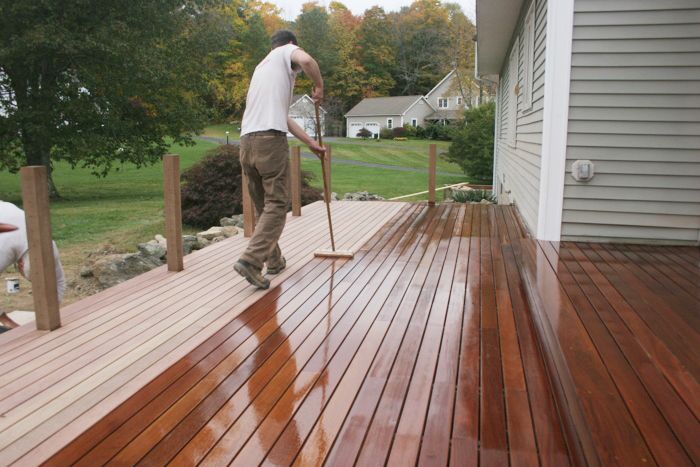How to Make a Deck Finish Last
Your choice of deck stain may not be as important as the maintenance regimen you follow over the life of your deck.

I regularly get asked, “What stain should I use on my wood deck?” As someone who used to build decks and whose journalistic specialty since 2007 has been decks, I don’t have a clue. Any number of manufacturers make good deck stains (see the partial list below). But even the best are only going to last 3 years. Hey, decks are horizontal, exterior surfaces that get walked on. What did you expect?
It’s all about the maintenance
What you should expect in order to keep a deck looking its best is to clean it at least annually, and to refinish it every year or two depending on the climate. Still, there are some tips that can help to maximize finish life.
Some decks live in the sun, whose UV radiation destroys the lignin that holds the cellulose fibers of the wood together. This allows the surface of the wood itself to slough off, taking the finish with it. UV inhibitors in the finish can help to manage this. Clear finishes tend to have fewer UV inhibitors than pigmented stains, and some have none, so use a pigmented stain.
Some decks see full shade and rarely dry out. Wood is an organic material, and it will support mold and algae growth. That’s made worse by nature’s grunge such as tree sap and pollen, which can even foster mold growth on plastic decking. Add to that such things as beer, soda, and ketchup spills, and it’s obvious that decks barely stand a chance. Keep your deck clean, and use a finish with a mildewcide.
Some decks are built close to wet ground, and the vapor pressure from below blows off any solid stain. Don’t use solid stains, build your deck a few feet above the ground if possible to encourage air circulation, and manage the ground moisture. For example, don’t drain gutters below the deck. If you do build your deck low, put a 3-in. layer of 3/4-in. gravel on the ground below. Water moves up through the soil by way of capillary action, and it can only travel this way from larger cavities to smaller ones. The gravel creates a layer of larger cavities to interrupt capillary flow, reducing the amount of moisture available to transpire to the air.
Regular refinishing can be easier than letting the deck go. If you refinish before the wood is damaged, you’ll get by with cleaning and reapplying a finish. Let the finish deteriorate until the wood shows through and it begins to crack, and you’ll be sanding the deck too.
Here are some (but not all) of the manufacturers that produce high-quality deck finishes:
Fine Homebuilding Recommended Products
Fine Homebuilding receives a commission for items purchased through links on this site, including Amazon Associates and other affiliate advertising programs.

4-Gallon Piston Backpack Sprayer

Cepco BoWrench Decking Tool

Lithium-Ion Cordless Palm Nailer






View Comments
Great finishing touch.
I would certainly consider refinishing my deck too before i spend end up money.
I can't believe Penofin is on this list. It is a terrible product. I used it PRECISELY as specified on a cedar deck (yes, sanded off mill scale) and it turned black in no time. It also lasted less than 6 months. Discoloration and poor durability are very common.